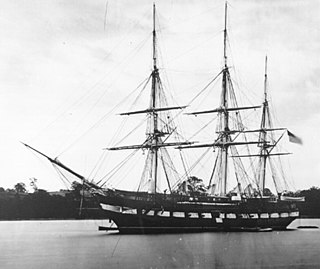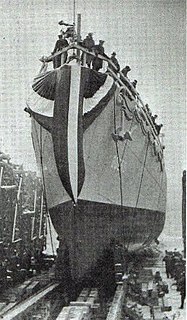A trumpeter is a musician who plays the trumpet.
Contents
Trumpeter may also refer to:
A trumpeter is a musician who plays the trumpet.
Trumpeter may also refer to:
Birds:
Fish:
Sultana or Sultanah may refer to:
A seagull or gull is a sea bird in the family Laridae.

In the 18th century and most of the 19th, a sloop-of-war in the Royal Navy was a warship with a single gun deck that carried up to eighteen guns. The rating system covered all vessels with 20 guns and above; thus, the term sloop-of-war encompassed all the unrated combat vessels, including the very small gun-brigs and cutters. In technical terms, even the more specialised bomb vessels and fireships were classed as sloops-of-war, and in practice these were employed in the sloop role when not carrying out their specialised functions.

A light aircraft carrier, or light fleet carrier, is an aircraft carrier that is smaller than the standard carriers of a navy. The precise definition of the type varies by country; light carriers typically have a complement of aircraft only one-half to two-thirds the size of a full-sized fleet carrier. A light carrier was similar in concept to an escort carrier in most respects, however light carriers were intended for higher speeds to be deployed alongside fleet carriers, while escort carriers usually defended convoys and provided air support during amphibious operations.
Abercrombie may refer to:

Destroyer escort (DE) was the United States Navy mid-20th-century classification for a 20-knot warship designed with the endurance necessary to escort mid-ocean convoys of merchant marine ships.

The Tacoma class of patrol frigates served in the United States Navy during World War II and the Korean War. Originally classified as gunboats (PG), they were reclassified as patrol frigates (PF) on 15 April 1943. The class is named for its lead ship, Tacoma, a Maritime Commission (MARCOM) S2-S2-AQ1 design, which in turn was named for the city of Tacoma, Washington. Twenty-one ships were transferred to the British Royal Navy, in which they were known as Colony-class frigates, and twenty-eight ships were transferred under Lend-Lease to the Soviet Navy, where they were designated as storozhevoi korabl, during World War II. All Tacoma-class ships in US service during World War II were manned by United States Coast Guard crews. Tacoma-class ships were transferred to the United States Coast Guard and various navies post-World War II.
Goliath was a giant famous for his battle with David as described in the Hebrew Bible.
Pigeon is a common name for birds of the taxonomic family Columbidae, particularly the rock pigeon.

The River class was a class of 151 frigates launched between 1941 and 1944 for use as anti-submarine convoy escorts in the North Atlantic. The majority served with the Royal Navy (RN) and Royal Canadian Navy (RCN), with some serving in the other Allied navies: the Royal Australian Navy (RAN), the Free French Navy (FFN), the Royal Netherlands Navy and, post-war, the South African Navy (SAN).

HMS Byard was a Captain-class frigate of the Royal Navy during World War II. She was named for Sir Thomas Byard, who commanded HMS Bedford at the Battle of Camperdown in 1797 during the French Revolutionary Wars.
Wild Goose may refer to:

Diffused lighting camouflage was a form of active camouflage using counter-illumination to enable a ship to match its background, the night sky, that was tested by the Royal Canadian Navy on corvettes during World War II. The principle was discovered by a Canadian professor, Edmund Godfrey Burr, in 1940. It attracted interest because it could help to hide ships from submarines in the Battle of the Atlantic, and the research project began early in 1941. The Royal Navy and the US Navy carried out further equipment development and trials between 1941 and 1943.

HMS Calpe was a British Royal Navy Type II Hunt-class destroyer escort. Built as a result of the outbreak of World War II, Calpe escorted convoys during the war and participated in the Dieppe Raid. Calpe is an old name for Gibraltar. Collaborating with USS Wainwright on 13 December 1943, she assisted in the sinking of German U-boat U-593. Calpe was loaned and then sold to the Danish Navy, remaining active until she was scrapped in Sweden in 1966.
HMS Duff (K352) was a British Captain-class frigate of the Royal Navy that served during World War II. Originally constructed as the United States Navy Buckley class destroyer escort USS Lamons (DE-64), she was transferred to the Royal Navy before she was completed.
HMS Domett (K473) was a British Captain-class frigate of the Royal Navy in commission during World War II. Originally constructed as the United States Navy Evarts-class destroyer escort USS Eisner (DE-269), she served in the Royal Navy from 1943 to 1946.
HMS Gardiner (K478) was a British Captain-class frigate of the Royal Navy in commission during World War II. Originally constructed as the United States Navy Evarts-class destroyer escort USS O'Toole (DE-274), she served in the Royal Navy from 1943 to 1946.
HMS Kingsmill (K484) was a British Captain-class frigate of the Royal Navy in commission during World War II. Originally constructed as the United States Navy Evarts-class destroyer escort DE-280, she served in the Royal Navy from 1943 to 1945 and then in the U.S. Navy as USS Kingsmill (DE-280) from August to October 1945.
HMS Veronica was a Flower-class corvette, built for the Royal Navy during the Second World War, and was in service in the Battle of the Atlantic. In 1942 she was transferred to the United States Navy as part of the reverse Lend Lease arrangement and renamed USS Temptress, the name ship of the Temptress-class gunboats. With the end of hostilities she was returned to the Royal Navy and sold into mercantile service.